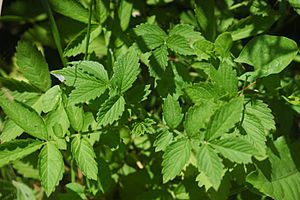Agrimonia pilosa facts for kids
Quick facts for kids Agrimonia pilosa |
|
|---|---|
 |
|
| Scientific classification | |
| Genus: |
Agrimonia
|
| Species: |
pilosa
|
Agrimonia pilosa (Hangul: 짚신나물), also known as hairy agrimony, is a pretty flowering plant. It belongs to the Rosaceae family, which also includes roses and apples! You can find this plant growing in places like the Korean Peninsula, Japan, China, Siberia, and parts of Eastern Europe.
What is Hairy Agrimony?
Hairy agrimony is a herb that comes back every year. This means it's a perennial plant. It has a straight stem that can grow quite tall, from about 30 to 120 centimeters (about 1 to 4 feet) high. You'll often spot it growing along roadsides or in grassy areas, even at different heights above sea level. It's not too picky about soil and can grow in sandy, loamy (a mix of sand, silt, and clay), or heavy soils. It likes soils that are either a bit acidic or basic (alkaline).
This plant has many side roots, and its underground stem (called a rhizome) is short and often looks like a small tuber. The stems are yellowish-green or green. The top part of the stem has a few soft hairs, while the lower part is covered in many dense hairs.
Its leaves are green and grow in an alternating pattern along the stem. They are odd-pinnate, meaning they have leaflets arranged on either side of a central stem, with a single leaflet at the end. There are usually two to four pairs of leaflets, but the leaves higher up on the plant might only have three leaflets. The leaflets are oval-shaped with pointy, even teeth along their edges. Each leaflet is about 3 to 6 centimeters long and 1.5 to 3.5 centimeters wide. Both sides of the leaves are hairy.
Natural Chemicals in the Plant
Agrimonia pilosa contains special natural chemicals. These include substances like agrimonolide, coumarin, and tannins. It also has flavonoids, phenylpropanoids, and triterpenes. These are all types of compounds found in plants.
Traditional Uses
For a long time, people have used Agrimonia pilosa in traditional medicine.
- In Korea, it has been used to help with skin problems like boils (sore bumps on the skin) and eczema (itchy, red skin). It was also used for a condition caused by tapeworms.
- In places like Nepal and China, A. pilosa is traditionally used to help with tummy aches (abdominal pain), sore throats, headaches, and even heat stroke (when your body gets too hot).
See also
 In Spanish: Agrimonia pilosa para niños
In Spanish: Agrimonia pilosa para niños


